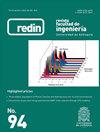Agricultural Use of Biosolids Generated in Wastewater Treatment of a Food Industry
IF 0.5
Q3 ENGINEERING, MULTIDISCIPLINARY
Revista Facultad De Ingenieria-universidad De Antioquia
Pub Date : 2020-03-28
DOI:10.19053/01211129.v29.n54.2020.10666
引用次数: 1
Abstract
Biosolids generated as waste from a Wastewater Treatment Plant (WTP) are a pollution problem by the provision of large volumes in landfills and the waste of their potential as an agricultural input. The research conducted trials to analyze the agricultural use of biosolids in a food company's WTP, their effects on the germination and development of the vegetal plant species Coriandrum sativum were assessed through trials that mixed different amounts of biosolids, land soil and commercial fertilizer, and took into account: planting site characteristics, biosolid and Coriandrum sativum. A random block design was made to compare treatments understudy and resulted in the combination of 50% biosolids with 50% land soil was the best test by germination, height, mass and length of the roots of the plant studied. In the evaluation of results, the behavior of dependent variables was analyzed: germination, height, mass and length with respect to the four test types with their respective repetitions using ANOVA and Fisher's significant minimum difference (LSD) to determine the effect the biosolid had on the plant and to know the optimal dose for its development. The germination rate (GR) was also determined in the trials, and 98.3% was found for the best treatment indicating that the substrate does not contain phytotoxic elements.食品工业废水处理中产生的生物固体的农业利用
废水处理厂(WTP)产生的作为废物的生物固体是一个污染问题,因为垃圾填埋场提供了大量的生物固体,并且浪费了它们作为农业投入的潜力。本研究在某食品公司的WTP中进行了生物固体的农业利用试验,通过混合不同量的生物固体、土地土壤和商业肥料,并考虑到种植场地特征、生物固体和芫荽的试验,评估了它们对蔬菜植物物种芫荽的萌发和发育的影响。采用随机区组设计比较不同处理间的差异,结果表明50%生物固体与50%土地土壤的组合以植物的发芽率、根系的高度、质量和长度为最佳。在评价结果时,利用方差分析和Fisher's significant minimum difference (LSD)分析了四种试验类型及其各自重复的因变量:萌发、高度、质量和长度的行为,以确定生物固体对植物的影响,并了解其发育的最佳剂量。试验还测定了发芽率(GR),发现最佳处理的发芽率为98.3%,表明底物不含植物毒性元素。
本文章由计算机程序翻译,如有差异,请以英文原文为准。
求助全文
约1分钟内获得全文
求助全文
来源期刊
CiteScore
2.00
自引率
0.00%
发文量
27
审稿时长
2 months
期刊介绍:
Revista Facultad de Ingenieria started in 1984 and is a publication of the School of Engineering at the University of Antioquia.
The main objective of the journal is to promote and stimulate the publishing of national and international scientific research results. The journal publishes original articles, resulting from scientific research, experimental and or simulation studies in engineering sciences, technology, and similar disciplines (Electronics, Telecommunications, Bioengineering, Biotechnology, Electrical, Computer Science, Mechanical, Chemical, Environmental, Materials, Sanitary, Civil and Industrial Engineering).
In exceptional cases, the journal will publish insightful articles related to current important subjects, or revision articles representing a significant contribution to the contextualization of the state of the art in a known relevant topic. Case reports will only be published when those cases are related to studies in which the validity of a methodology is being proven for the first time, or when a significant contribution to the knowledge of an unexplored system can be proven.
All published articles have undergone a peer review process, carried out by experts recognized for their knowledge and contributions to the relevant field.
To adapt the Journal to international standards and to promote the visibility of the published articles; and therefore, to have a greater impact in the global academic community, after November 1st 2013, the journal will accept only manuscripts written in English for reviewing and publication.
Revista Facultad de Ingeniería –redin is entirely financed by University of Antioquia
Since 2015, every article accepted for publication in the journal is assigned a DOI number.

 求助内容:
求助内容: 应助结果提醒方式:
应助结果提醒方式:


